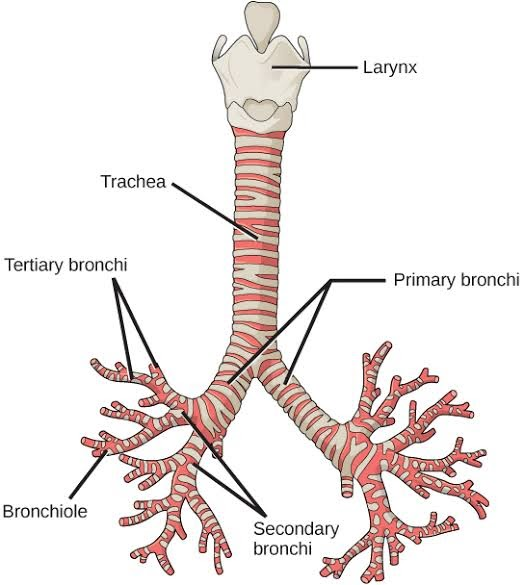
The tube into which the trachea divides to go into each lung is called what?
Answer
473.1k+ views
Hint: Your lungs provide oxygen to your body while also removing other gases such as carbon dioxide. This happens somewhere between 12 and 20 times every minute. Air goes down the pharynx (back of the throat), past the larynx (voice box), and into the trachea when you inhale through your nose or mouth (windpipe). There are two air passageways in your trachea.
Complete answer:
When the trachea hits the lungs, it splits into two bronchi. The trachea separates into two tubes as it reaches the lungs: the right bronchus and the left bronchus. Each of them makes its way into a lung.
Smooth muscle, cartilage, and cilia are all structurally similar in the trachea and bronchi. The bronchi, on the other hand, are only a few centimetres in diameter, whereas the trachea is roughly centimetres.
The bronchi receives air from the trachea. The bronchi then divide into a vast network of smaller airways known as bronchioles, which transport blood to the alveoli, where gas exchange takes place.
Air goes down the pharynx (back of the throat), past the larynx (voice box), and into the trachea when you inhale through your nose or mouth (windpipe). Your trachea is separated into two bronchial tubes, which are air channels. The left lung is served by one bronchial tube, whereas the right lung is served by the other.

Bronchioles are air passageways within the lungs that branch off like tree limbs from the bronchi—the two main air passages into which air flows after being inhaled through the nose or mouth. The bronchioles transport air to tiny sacs called alveoli, which exchange oxygen and carbon dioxide.
Note:-
The respiratory system (also respiratory apparatus, ventilatory system) is a biological system consisting of specific organs and structures used for gas exchange in animals and plants. The anatomy and physiology that make this happen varies greatly, depending on the size of the organism, the environment in which it lives and its evolutionary history. In land animals the respiratory surface is internalized as linings of the lungs.
Complete answer:
When the trachea hits the lungs, it splits into two bronchi. The trachea separates into two tubes as it reaches the lungs: the right bronchus and the left bronchus. Each of them makes its way into a lung.
Smooth muscle, cartilage, and cilia are all structurally similar in the trachea and bronchi. The bronchi, on the other hand, are only a few centimetres in diameter, whereas the trachea is roughly centimetres.
The bronchi receives air from the trachea. The bronchi then divide into a vast network of smaller airways known as bronchioles, which transport blood to the alveoli, where gas exchange takes place.
Air goes down the pharynx (back of the throat), past the larynx (voice box), and into the trachea when you inhale through your nose or mouth (windpipe). Your trachea is separated into two bronchial tubes, which are air channels. The left lung is served by one bronchial tube, whereas the right lung is served by the other.

Bronchioles are air passageways within the lungs that branch off like tree limbs from the bronchi—the two main air passages into which air flows after being inhaled through the nose or mouth. The bronchioles transport air to tiny sacs called alveoli, which exchange oxygen and carbon dioxide.
Note:-
The respiratory system (also respiratory apparatus, ventilatory system) is a biological system consisting of specific organs and structures used for gas exchange in animals and plants. The anatomy and physiology that make this happen varies greatly, depending on the size of the organism, the environment in which it lives and its evolutionary history. In land animals the respiratory surface is internalized as linings of the lungs.
Recently Updated Pages
Master Class 12 Business Studies: Engaging Questions & Answers for Success

Master Class 12 Economics: Engaging Questions & Answers for Success

Master Class 12 English: Engaging Questions & Answers for Success

Master Class 12 Maths: Engaging Questions & Answers for Success

Master Class 12 Social Science: Engaging Questions & Answers for Success

Master Class 12 Chemistry: Engaging Questions & Answers for Success

Trending doubts
What is meant by exothermic and endothermic reactions class 11 chemistry CBSE

Which animal has three hearts class 11 biology CBSE

10 examples of friction in our daily life

One Metric ton is equal to kg A 10000 B 1000 C 100 class 11 physics CBSE

1 Quintal is equal to a 110 kg b 10 kg c 100kg d 1000 class 11 physics CBSE

Difference Between Prokaryotic Cells and Eukaryotic Cells




